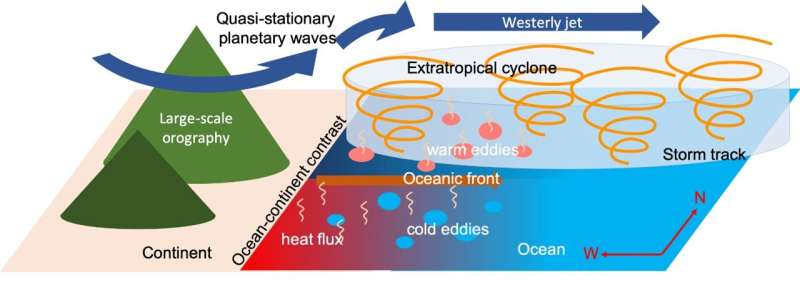Weather to climate: More research needed to understand sea-air influences

Red sky at night, sailor's delight. Red sky in the morning, sailor's warning. The adage holds some truth: the relationship between ocean and atmosphere can be smooth sailing or stormy. Yet, despite extensive research on their co-dependence, it is still not fully understood how sea-air interactions influence weather and climate and everything in between, according to a research team based in China.
Guidi Zhou and Xuhua Cheng, both researchers at Hohai University, examined more than 250 papers focused on these interactions, with an emphasis on currents and boundaries in the North Pacific Ocean. While there were some consistent findings in the peer-reviewed scientific studies dating from this year to the late 1980s, the researchers said more investigation is needed.
They published their review on Sept. 22 in Advances in Atmospheric Sciences.
"Given the numerous research efforts which sometimes yield conflicting and perplexing results, we believe it is timely to review the currently available studies, make an informative comparison of their results, organize the knowns and unknowns, and try to provide insights for future research," Zhou said.
The team focused on research concerning the Kuroshio-Oyashio Extension region in the North Pacific Ocean, which is where the warm Kuroshio Extension from the Japanese coast meets with the cold Oyashio Extension from the subarctic sea to form the North Pacific Current. Oceanic processes in this region are complex and dynamic, Zhou said, due to powerful currents, multiple ocean fronts that mark the divide between water masses and several circular currents that can stretch up to 1,000 kilometers.
"The atmospheric storm track and circulation, as well as their interaction, have been extensively studied in meteorology for decades, yet our current knowledge on mesoscale ocean perturbations and their interaction with oceanic jets is still limited," Zhou said.
The mesoscale describes the in-between of weather and climate, typically comprising a large area and can influence a variety of weather events. For example, the same eddy may circulate through calm or stormy areas—but whether the eddy contributes to the resulting weather is not well understood, according to Zhou.
"Based on the current understanding of the research, ocean fronts and eddies most likely do impact the atmosphere in terms of driving changes to both weather and climate," Zhou said, noting that the eddies and fronts may even be able to influence atmospheric changes that last about a decade. "Large uncertainties, however, are present and much more in-depth investigation is needed."
More information: Guidi Zhou et al, Impacts of Oceanic Fronts and Eddies in the Kuroshio-Oyashio Extension Region on the Atmospheric General Circulation and Storm Track, Advances in Atmospheric Sciences (2021). DOI: 10.1007/s00376-021-0408-4
Journal information: Advances in Atmospheric Sciences
Provided by Chinese Academy of Sciences

















